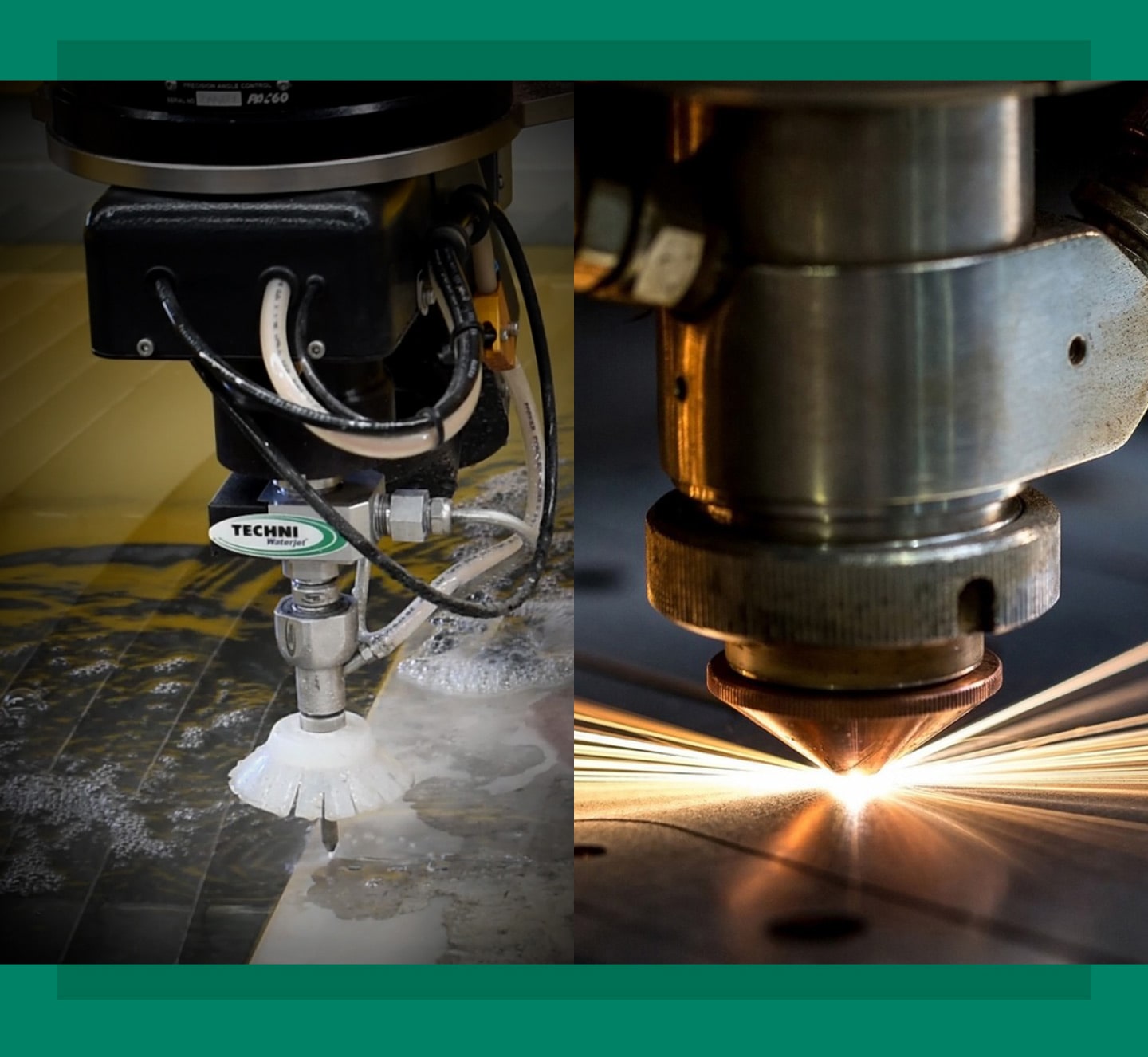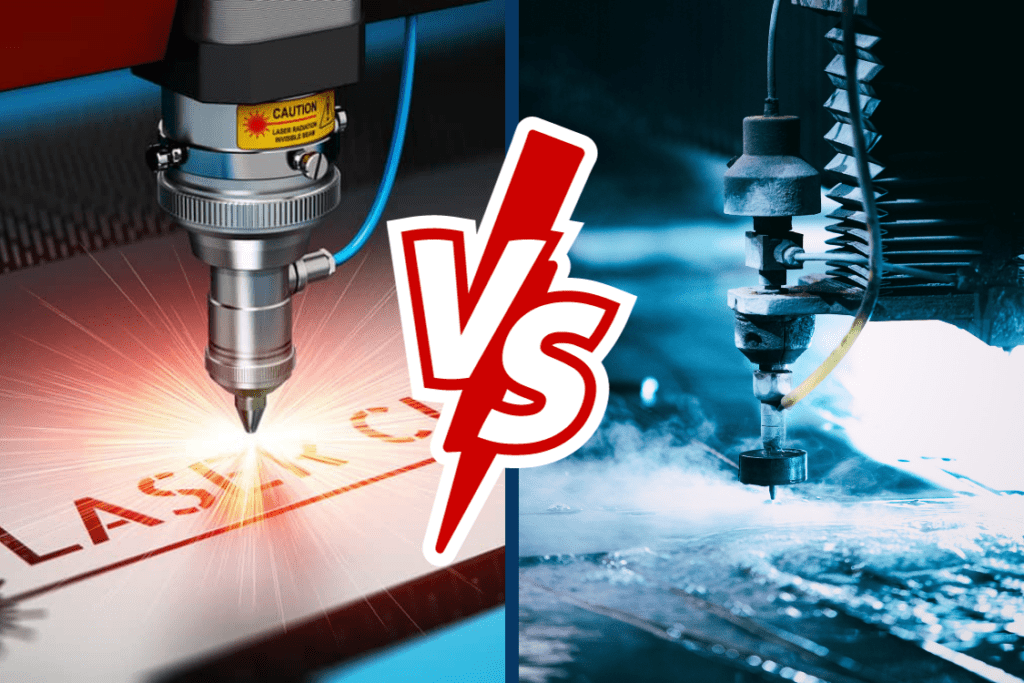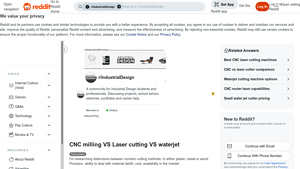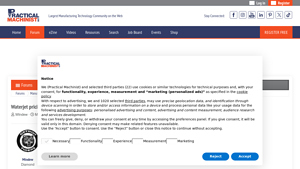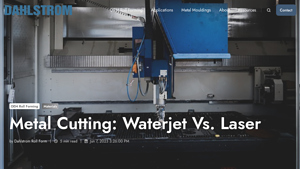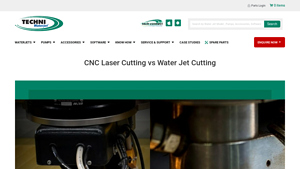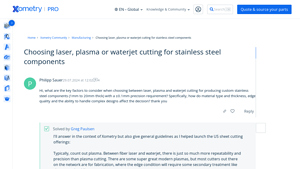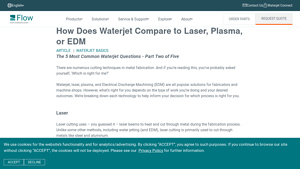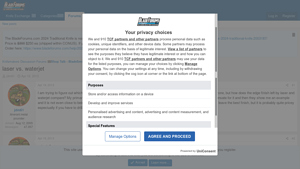Laser Vs Waterjet Guide: Type, Cost, Top List…
Introduction: Navigating the Global Market for laser vs waterjet
In the fast-evolving landscape of manufacturing, selecting the right cutting technology can be a pivotal challenge for international B2B buyers. Whether you’re sourcing advanced laser cutting or versatile waterjet cutting solutions, understanding the nuances between these two methods is essential for optimizing production efficiency and material utilization. This comprehensive guide delves into the critical aspects of laser vs. waterjet cutting, exploring their distinct characteristics, applications, and advantages, as well as providing insights into supplier vetting and cost considerations.
International buyers from regions such as Africa, South America, the Middle East, and Europe—countries like Nigeria and Vietnam—face unique challenges when navigating the global market. This guide aims to empower your decision-making process by offering actionable insights that cater specifically to your operational needs. From evaluating the types of materials suited for each cutting technique to understanding the long-term cost implications and maintenance requirements, we cover it all.
By equipping yourself with this knowledge, you can make informed purchasing decisions that align with your company’s strategic goals, ensuring that you invest in the right technology for your manufacturing processes. As you embark on this journey, let this guide serve as your trusted resource in the pursuit of cutting-edge solutions that drive efficiency and enhance productivity.
Understanding laser vs waterjet Types and Variations
| Type Name | Key Distinguishing Features | Primary B2B Applications | Brief Pros & Cons for Buyers |
|---|---|---|---|
| CO2 Laser Cutting | Utilizes CO2 gas for generating laser beams; effective for non-metal materials. | Wood, acrylic, textiles, and plastics. | Pros: Cost-effective for non-metals; good for intricate designs. Cons: Limited to softer materials, less effective on metals. |
| Fiber Laser Cutting | Employs fiber optics to generate high-power laser beams; excels in metal cutting. | Metals like stainless steel, aluminum, and brass. | Pros: High speed and precision; minimal material waste. Cons: Higher initial investment; requires skilled operation. |
| Waterjet Cutting | Uses high-pressure water, often mixed with abrasives; suitable for thick and hard materials. | Stone, glass, metals, and composites. | Pros: No heat-affected zones; can cut thick materials up to 300 mm. Cons: Slower than laser cutting; higher operational costs. |
| Abrasive Waterjet | A variation of waterjet cutting that incorporates abrasives for enhanced cutting power. | Heavy-duty applications in manufacturing and construction. | Pros: Effective for tough materials; clean cuts with minimal finishing. Cons: Expensive due to abrasive costs; frequent maintenance needed. |
| Pure Waterjet | Focuses solely on water without abrasives; ideal for softer materials. | Foam, rubber, and some plastics. | Pros: Environmentally friendly; no heat generation. Cons: Limited to softer materials; slower than laser cutting. |
What are the Characteristics and Suitability of CO2 Laser Cutting?
CO2 laser cutting is characterized by its use of carbon dioxide gas to produce a powerful laser beam. This method is particularly effective for cutting non-metal materials such as wood, acrylic, textiles, and plastics. B2B buyers should consider CO2 laser cutting when their projects involve intricate designs on softer materials, as it offers a cost-effective solution with good precision. However, its limitations include an inability to effectively cut through metals and the potential for heat damage on certain substrates.
How Does Fiber Laser Cutting Stand Out in Metal Applications?
Fiber laser cutting utilizes advanced fiber optic technology to generate high-intensity laser beams, making it an ideal choice for cutting metals like stainless steel, aluminum, and brass. Its speed and precision are significant advantages, resulting in minimal waste and high-quality finishes. B2B buyers should evaluate fiber laser cutting for projects requiring detailed metalwork, although the initial investment may be higher compared to other methods. Skilled operation is essential to maximize its benefits and maintain efficiency.
What are the Advantages of Waterjet Cutting for Thick Materials?
Waterjet cutting operates by directing a high-pressure stream of water, often mixed with abrasives, to cut through various materials, including metals and stone. This method is particularly advantageous for thick materials, with capabilities of cutting up to 300 mm. B2B buyers should consider waterjet cutting for applications where heat generation could damage the material, as it avoids heat-affected zones. However, it is generally slower than laser cutting and incurs higher operational costs, making it crucial to assess project timelines and budgets.
When Should Businesses Consider Abrasive Waterjet Cutting?
Abrasive waterjet cutting is a specialized variation that enhances cutting power by incorporating abrasive materials into the water stream. This technique is ideal for heavy-duty applications in manufacturing and construction, effectively cutting through tough materials while producing clean edges that often require minimal finishing. B2B buyers should weigh the benefits of abrasive waterjet cutting against its higher costs and maintenance needs, as the abrasives can significantly increase operational expenses.
What is the Role of Pure Waterjet Cutting in Soft Material Applications?
Pure waterjet cutting focuses solely on using water to cut materials, making it suitable for softer substrates like foam, rubber, and certain plastics. This method is environmentally friendly and generates no heat, preserving the integrity of the material. B2B buyers may find pure waterjet cutting advantageous for projects that prioritize sustainability and require a clean cutting process. However, its slower cutting speed and limitations to softer materials should be considered in the decision-making process.
Key Industrial Applications of laser vs waterjet
| Industry/Sector | Specific Application of laser vs waterjet | Value/Benefit for the Business | Key Sourcing Considerations for this Application |
|---|---|---|---|
| Aerospace | Precision cutting of aircraft components | High accuracy and reduced material wastage | Consider machine speed, precision, and material compatibility. |
| Automotive | Cutting and engraving of interior parts | Enhanced design flexibility and lower production costs | Evaluate the machine’s ability to handle various materials and thicknesses. |
| Metal Fabrication | Structural steel cutting | Faster production cycles and improved tolerances | Focus on maintenance requirements and operational costs. |
| Stone and Tile Industry | Custom stone cutting | Ability to create intricate designs with minimal waste | Assess water quality and abrasive management for optimal performance. |
| Electronics | Circuit board fabrication | High precision and reduced risk of thermal damage | Determine the machine’s compatibility with sensitive materials. |
How is Laser Cutting Applied in the Aerospace Industry?
In the aerospace sector, laser cutting is widely used for precision cutting of aircraft components such as brackets, panels, and fuselage parts. The high accuracy of laser technology minimizes material wastage, which is crucial given the stringent safety and performance requirements in aviation. International buyers, especially from regions like Africa and the Middle East, should consider sourcing machines that offer both speed and precision, as well as support for various materials, including lightweight composites and metals.
What are the Benefits of Waterjet Cutting in the Automotive Sector?
Waterjet cutting plays a significant role in the automotive industry, particularly for cutting and engraving interior parts like dashboards and trims. This method allows for intricate designs without the risk of melting or warping materials, which is vital in maintaining aesthetic quality. For B2B buyers in South America and Europe, it is essential to evaluate the machine’s capacity to handle diverse materials and thicknesses, alongside operational costs, to ensure efficient production.
Why is Metal Fabrication Relying on Laser Cutting Technology?
In metal fabrication, laser cutting is preferred for structural steel cutting due to its speed and precision. This technology enables faster production cycles and improved dimensional tolerances, which are critical in industries where structural integrity is paramount. Buyers in regions like Nigeria and Vietnam should focus on sourcing machines that balance maintenance needs with operational efficiency, as well as the ability to cut various metal types.
How Does Waterjet Cutting Enhance Custom Stone Fabrication?
Waterjet cutting is particularly advantageous in the stone and tile industry, where it allows for custom cutting of intricate designs. This method produces minimal waste and maintains the integrity of the material, making it ideal for high-end applications. International buyers should assess the sourcing of quality abrasives and manage water quality to optimize the cutting process, ensuring they can meet both aesthetic and structural requirements.
What Role Does Laser Cutting Play in Electronics Manufacturing?
In electronics manufacturing, laser cutting is crucial for fabricating circuit boards with high precision. This technology minimizes the risk of thermal damage to sensitive components, ensuring product reliability. B2B buyers must consider machines that are compatible with various substrates and can deliver consistent results, as well as the necessary support for maintenance and training, particularly in emerging markets.
3 Common User Pain Points for ‘laser vs waterjet’ & Their Solutions
Scenario 1: The Dilemma of Material Compatibility
The Problem: B2B buyers often face challenges in selecting the right cutting technology due to the varying compatibility of materials with laser and waterjet cutting. For instance, a manufacturer in Nigeria may need to cut through a range of materials, including metals, plastics, and rubber. However, they may not be aware that certain materials, like tempered glass and thermolabile substances, are unsuitable for laser cutting due to the heat generated, while abrasive waterjet cutting can struggle with precision on thinner materials. This lack of clarity can lead to delays in production and increased costs if the wrong technology is employed.
The Solution: To mitigate this issue, buyers should conduct a comprehensive material analysis before making a decision. First, they can consult with suppliers or cutting service providers to understand the specific material properties and the best cutting methods for each. Creating a material compatibility chart that outlines which materials work best with laser and waterjet technologies can be invaluable. Additionally, utilizing CAD (computer-aided design) software to simulate cutting processes can help visualize potential issues and refine the selection. By taking these proactive steps, businesses can avoid costly mistakes and ensure smoother production workflows.
Scenario 2: Navigating Cost and Efficiency Trade-offs
The Problem: Another common pain point for international B2B buyers, particularly in cost-sensitive markets like South America, is balancing the initial investment and operational costs of laser versus waterjet cutting systems. Waterjet machines generally have higher upfront costs and ongoing maintenance expenses, which can deter companies from choosing them even when they might be better suited for specific applications, such as cutting thick materials. This financial uncertainty can lead to indecision or opting for suboptimal solutions that do not meet production needs.
The Solution: Buyers should perform a total cost of ownership (TCO) analysis that includes not only the purchase price of the cutting technology but also operational costs, maintenance, and potential downtime. It’s essential to account for the specific applications that each method will handle. For example, if a company regularly works with materials exceeding 1 inch in thickness, waterjet cutting may offer long-term savings despite higher initial costs due to its ability to handle thicker materials more effectively. Engaging with experienced consultants who can provide insights into the long-term benefits of each technology can help in making informed decisions. Furthermore, exploring leasing options for high-cost machinery can also mitigate upfront expenses while allowing businesses to assess their cutting needs before committing to a purchase.
Scenario 3: The Challenge of Precision and Quality
The Problem: Precision and quality are paramount in manufacturing, and buyers often struggle with the dimensional tolerances achievable by laser and waterjet cutting. A European automotive parts manufacturer may find that while laser cutting offers higher precision, it may not be the best choice for softer materials that could warp under heat. Conversely, while waterjet cutting is effective for thicker materials, it may produce slightly rougher edges, necessitating additional finishing processes. This dilemma can lead to inconsistency in product quality and increased labor costs for post-processing.
The Solution: To address these challenges, companies should invest in high-quality cutting machines that suit their specific production needs. For precision applications, buyers should prioritize laser cutting for materials that can withstand heat without deformation, while opting for waterjet cutting when working with heat-sensitive materials. Implementing a robust quality control system that includes pre- and post-cutting inspections can help maintain standards across both methods. Additionally, investing in training for operators on the nuances of each cutting technology can enhance the overall output quality. Collaborating with machine manufacturers to customize settings for specific materials can also yield better results, ensuring that the final products meet the required specifications without excessive post-processing.
Strategic Material Selection Guide for laser vs waterjet
How Do Different Materials Perform with Laser and Waterjet Cutting?
When selecting between laser and waterjet cutting, understanding the properties and applications of common materials is crucial for B2B buyers. This guide examines four prevalent materials—stainless steel, aluminum, acrylic, and rubber—highlighting their characteristics, advantages, disadvantages, and considerations for international markets.
What Are the Key Properties of Stainless Steel for Cutting?
Stainless steel is renowned for its corrosion resistance and high strength, making it suitable for various applications, including automotive and construction. It can withstand high temperatures and pressures, which is essential in demanding environments.
Pros & Cons:
Laser cutting offers high precision with minimal kerf width, making it ideal for intricate designs. However, it can be more expensive for thicker gauges, as it typically handles up to 30-40 mm effectively. Waterjet cutting can handle thicker materials (up to 300 mm) without heat-affected zones, but it may not achieve the same level of precision, particularly in fine details.
Impact on Application:
Stainless steel is often used in environments that require durability and resistance to oxidation. For international buyers, compliance with standards like ASTM A240 is critical, especially in industries such as food processing or pharmaceuticals.
How Does Aluminum Compare in Laser and Waterjet Cutting?
Aluminum is lightweight, corrosion-resistant, and possesses excellent thermal conductivity, making it a popular choice in aerospace and automotive sectors.
Pros & Cons:
Laser cutting is highly efficient for aluminum, delivering clean edges and high speeds (up to 70 inches per minute). However, reflective surfaces can pose challenges, leading to potential warping. Waterjet cutting can mitigate these issues but is generally slower and more costly for thinner aluminum sheets.
Impact on Application:
Buyers should consider compliance with international standards such as ASTM B221. In regions like Africa and South America, where aluminum is often used in construction, understanding local regulations regarding material specifications is essential.
What Makes Acrylic a Preferred Material for Cutting Techniques?
Acrylic is a versatile plastic known for its clarity and impact resistance, often used in signage and display applications.
Pros & Cons:
Laser cutting excels with acrylic, providing smooth edges and intricate designs without the need for post-processing. However, it can produce fumes that require proper ventilation. Waterjet cutting is less effective for acrylic, as the slower process can lead to rough edges and increased waste.
Impact on Application:
For B2B buyers, especially in Europe, ensuring compliance with standards like EN 71 (safety of toys) is vital when using acrylic in consumer products. Understanding the local market demand for acrylic applications can also guide material selection.
Why Consider Rubber in Cutting Processes?
Rubber is commonly used in gaskets, seals, and cushioning applications due to its elasticity and resilience.
Pros & Cons:
Waterjet cutting is particularly advantageous for rubber, as it avoids melting and maintains the material’s properties. Conversely, laser cutting can damage rubber due to heat, leading to undesirable fumes and material degradation.
Impact on Application:
International buyers must consider the specific grades of rubber and their compliance with relevant standards, such as ASTM D2000 for rubber materials. In regions like the Middle East, where rubber is used in various industrial applications, understanding local sourcing and quality standards is crucial.
Summary Table of Material Comparisons
| Material | Typical Use Case for laser vs waterjet | Key Advantage | Key Disadvantage/Limitation | Relative Cost (Low/Med/High) |
|---|---|---|---|---|
| Stainless Steel | Automotive, construction | High precision with laser cutting | Expensive for thick gauges | High |
| Aluminum | Aerospace, automotive | Fast cutting speeds with laser | Reflective surface challenges | Medium |
| Acrylic | Signage, displays | Smooth edges and intricate designs | Produces fumes with laser cutting | Low |
| Rubber | Gaskets, seals | Maintains properties with waterjet | Laser cutting can damage material | Medium |
This strategic material selection guide provides actionable insights for B2B buyers, enabling informed decisions based on material properties, application suitability, and international compliance considerations.
In-depth Look: Manufacturing Processes and Quality Assurance for laser vs waterjet
What Are the Key Stages in the Manufacturing Process of Laser and Waterjet Cutting?
In the realm of precision cutting, both laser and waterjet technologies are pivotal. Understanding their manufacturing processes is essential for international B2B buyers who seek to optimize production efficiency and ensure quality. Here’s a breakdown of the key stages involved in each process.
Material Preparation: How Do You Get Started?
Before cutting begins, material selection and preparation are critical. For laser cutting, materials such as metals, plastics, and wood are commonly used. The chosen material must be free of contaminants and appropriately sized to fit the cutting bed. In contrast, waterjet cutting is more versatile, allowing for the cutting of materials that may be sensitive to heat, such as rubber or foam.
Both methods require that materials be securely fastened to the cutting surface to prevent movement during the cutting process. This is often achieved using clamps or a vacuum hold-down system.
What Techniques Are Used in Forming and Cutting?
The forming and cutting stage varies significantly between laser and waterjet cutting.
Laser Cutting:
– Technique: Laser cutting employs a focused beam of light that melts or vaporizes the material. The process is controlled via CAD software, which dictates the path of the laser.
– Speed and Precision: Laser cutting is known for its speed, capable of cutting materials at rates of 20-70 inches per minute, with a precision of up to 0.15 mm. This is especially advantageous for intricate designs requiring tight tolerances.
Waterjet Cutting:
– Technique: Waterjet cutting utilizes a high-pressure water stream, sometimes mixed with abrasives, to erode the material. This technique is particularly effective for thicker materials, allowing cuts up to 300 mm in thickness.
– Speed and Quality: Waterjet cutting operates at a slower rate of 1-20 inches per minute for similar thicknesses, but it offers a smooth finish that often requires minimal post-processing. The absence of heat generation means that materials remain unwarped and unblemished.
How Is Quality Assurance Managed in Laser and Waterjet Cutting?
Quality assurance (QA) is vital in both manufacturing processes to ensure the final products meet international standards and customer expectations.
Which International Standards Should B2B Buyers Be Aware Of?
International standards such as ISO 9001 are crucial for maintaining quality management systems. These standards help organizations ensure consistent quality in their products and services. Additionally, industry-specific certifications like CE (Conformité Européenne) for European markets and API (American Petroleum Institute) for oil and gas applications are essential for compliance and market acceptance.
What Are the Key Quality Control Checkpoints?
Quality control (QC) is typically segmented into various checkpoints throughout the manufacturing process:
-
Incoming Quality Control (IQC): This stage involves inspecting raw materials upon arrival. Buyers should verify that materials meet specified standards and documentation, such as certificates of compliance.
-
In-Process Quality Control (IPQC): During the cutting process, operators should monitor parameters like cutting speed, pressure, and material feed rates to ensure adherence to specifications. Regular checks help in identifying deviations early.
-
Final Quality Control (FQC): After cutting, the finished parts undergo inspections to verify dimensions, tolerances, and surface quality. Techniques such as laser scanning and coordinate measuring machines (CMM) are often employed.
How Can B2B Buyers Verify Supplier Quality Control?
For international B2B buyers, ensuring that suppliers adhere to quality standards is crucial. Here are some strategies:
-
Supplier Audits: Conducting on-site audits allows buyers to assess the supplier’s manufacturing processes, quality control measures, and compliance with international standards firsthand.
-
Quality Reports and Certifications: Requesting regular quality reports and certifications can provide insights into the supplier’s performance and adherence to quality standards.
-
Third-Party Inspections: Engaging third-party inspection agencies can help validate the quality of products before shipment. This is particularly important for buyers in regions like Africa, South America, and the Middle East, where local suppliers may have varying quality assurance practices.
What Are the Common Testing Methods Used in Quality Assurance?
Testing methods play a pivotal role in ensuring the quality of laser and waterjet cut products. Common methods include:
-
Dimensional Inspection: Utilizing tools such as calipers, micrometers, and CMMs to verify that parts meet specified dimensions and tolerances.
-
Surface Roughness Testing: Analyzing the surface finish of cut materials to ensure they meet the required smoothness levels, which can impact subsequent processing and product performance.
-
Material Testing: Conducting tensile, hardness, or metallurgical tests to ensure that the materials used meet the required specifications for strength and durability.
What Are the QC Nuances for International B2B Buyers?
International buyers must navigate various nuances in quality control, particularly when sourcing from different regions:
-
Cultural Differences: Understanding the cultural context of suppliers can impact communication and expectations regarding quality. Building strong relationships can facilitate better quality management.
-
Regulatory Compliance: Buyers must be aware of specific regulations in their target markets, as non-compliance can lead to delays or additional costs.
-
Logistical Challenges: Shipping and handling can introduce risks to product quality. Ensuring proper packaging and transportation methods is essential to maintain the integrity of the products.
In conclusion, both laser and waterjet cutting technologies offer unique advantages and challenges in manufacturing. By understanding the key manufacturing processes and implementing robust quality assurance measures, B2B buyers can ensure they receive high-quality products that meet their needs.
Practical Sourcing Guide: A Step-by-Step Checklist for ‘laser vs waterjet’
In the competitive landscape of manufacturing, selecting the right cutting technology—laser cutting or waterjet cutting—can significantly impact your production efficiency and costs. This guide provides a practical checklist for B2B buyers to streamline the procurement process of these technologies, ensuring informed decisions tailored to your operational needs.
Step 1: Define Your Technical Specifications
Start by clearly outlining your project requirements, including material types, thicknesses, and desired tolerances. Understanding the specific characteristics of your materials is essential, as laser cutting excels with thin materials like acrylic, while waterjet cutting is ideal for thicker, more robust materials. This step sets the foundation for evaluating which technology aligns best with your needs.
Step 2: Assess Cost Considerations
Evaluate the total cost of ownership for both laser and waterjet cutting technologies. Consider not only the initial purchase price but also operational costs such as maintenance, energy consumption, and consumables like abrasives for waterjets. Waterjet systems may have higher running costs due to abrasives and maintenance needs, so calculate the long-term financial implications before making a decision.
Step 3: Evaluate Supplier Capabilities
Conduct thorough research on potential suppliers. Look for companies with proven expertise in the specific cutting technology you are considering. Request case studies or examples of similar projects they have handled, and ensure that they have the necessary certifications to meet international standards. This will help you gauge their reliability and capability to meet your project demands.
Step 4: Inquire About Material Compatibility
Different cutting technologies excel with different materials. Ensure that the supplier can handle the specific materials you plan to cut. For example, if your project involves soft materials that may melt under heat, waterjet cutting may be more suitable. Confirming material compatibility can prevent costly mistakes later in the process.
Step 5: Request Detailed Quotes
Once you have shortlisted suppliers, request detailed quotes that include breakdowns of costs, lead times, and service agreements. Compare not only the pricing but also the value offered, such as post-processing services or support. This information will allow you to assess which supplier provides the best overall value for your specific requirements.
Step 6: Check for Technological Advancements
Evaluate whether the suppliers are utilizing the latest technology in their cutting processes. Modern advancements can enhance cutting speed, precision, and efficiency. Inquire about their machine capabilities and software used for programming cuts, as these factors can significantly affect production quality and turnaround times.
Step 7: Verify After-Sales Support and Maintenance
After-sales support is crucial for ensuring the longevity and efficiency of your cutting equipment. Discuss the supplier’s maintenance services, availability of spare parts, and training for your staff. A reliable supplier will offer comprehensive support to minimize downtime and keep your operations running smoothly.
By following this checklist, B2B buyers can make a well-informed decision when sourcing laser or waterjet cutting technologies, ultimately enhancing their manufacturing capabilities and achieving cost-effective solutions.
Comprehensive Cost and Pricing Analysis for laser vs waterjet Sourcing
When evaluating the cost and pricing analysis for laser versus waterjet cutting, it’s crucial to dissect the various cost components involved in both processes. This analysis aims to provide actionable insights for international B2B buyers, particularly those from regions such as Africa, South America, the Middle East, and Europe.
What Are the Key Cost Components for Laser and Waterjet Cutting?
Materials: The primary materials used in both laser and waterjet cutting significantly influence costs. Laser cutting typically handles a variety of materials, including metals, plastics, and wood. However, it may struggle with reflective materials. Waterjet cutting, on the other hand, excels with thicker materials, including metals and stone, and can accommodate abrasive materials, which can elevate costs.
Labor: Labor costs can vary based on the complexity of the cut and the skill level required. Laser cutting often requires less skilled labor for simpler cuts, while waterjet cutting may necessitate more expertise to manage the equipment and maintain quality, particularly when using abrasives.
Manufacturing Overhead: Overhead costs differ significantly between the two methods. Laser cutting machines, although potentially cheaper to purchase (ranging from $8,000 to $250,000), incur lower operational costs due to reduced energy consumption. Waterjet machines have higher upfront costs (ranging from $60,000 to $450,000) and can consume more energy and resources in terms of maintenance, especially with high-pressure pumps and nozzles that wear out faster.
Tooling: Tooling costs can be higher for waterjet cutting due to the need for specialized abrasive materials and frequent replacement of nozzles. In contrast, laser cutting requires periodic maintenance of lenses and mirrors but generally has lower tooling costs.
Quality Control (QC): Quality assurance practices are essential in both methods. Laser cutting offers tighter tolerances (0.15 mm) compared to waterjet cutting (0.5 mm), which can affect the overall cost if precision is paramount for the project.
Logistics: Transportation and logistics costs can vary based on the finished product’s weight and dimensions. Waterjet cutting may yield heavier finished parts due to the nature of its cutting process, leading to potentially higher shipping costs.
Margin: Supplier margins can vary widely. Waterjet cutting suppliers may charge a premium due to the higher operational and maintenance costs associated with their machinery.
What Influences Pricing for Laser and Waterjet Cutting?
Volume/MOQ: Pricing often scales with order volume. Higher volumes typically yield lower costs per unit due to economies of scale. Buyers should negotiate minimum order quantities (MOQs) that align with their production needs.
Specifications and Customization: The complexity of the cuts and specific requirements can drive up costs. Custom designs or intricate cuts may require additional programming time and setup, particularly in laser cutting.
Materials: The choice of material significantly impacts pricing. Premium materials will naturally incur higher costs, and buyers should consider sourcing strategies that optimize material use.
Quality and Certifications: Certifications for quality assurance (e.g., ISO standards) can also influence pricing. Suppliers with recognized certifications may command higher prices, but they often provide better reliability and assurance of quality.
Supplier Factors: The supplier’s reputation, experience, and geographical location can influence costs. Established suppliers may charge more due to their expertise, while those in emerging markets might offer competitive pricing.
Incoterms: Understanding Incoterms is vital for international buyers. Costs associated with shipping, insurance, and customs duties can significantly impact the total cost of ownership.
What Are the Best Tips for Buyers Looking to Optimize Costs?
-
Negotiate: Always engage suppliers in discussions about pricing, especially for larger orders. Leverage your volume to secure better rates.
-
Consider Total Cost of Ownership: Look beyond initial pricing; consider long-term operational and maintenance costs associated with both cutting methods.
-
Research Local Suppliers: Explore suppliers in your region to reduce shipping costs and improve lead times, especially if you are in Africa or South America.
-
Compare Quotes: Obtain multiple quotes from different suppliers to ensure you are getting the best deal for your specific needs.
-
Stay Informed on Pricing Nuances: Understand the market dynamics and fluctuations in material costs, as these can affect your overall project budget.
In conclusion, both laser and waterjet cutting offer distinct advantages and costs. By analyzing these factors carefully, international B2B buyers can make informed decisions that align with their manufacturing needs and budget constraints.
Alternatives Analysis: Comparing laser vs waterjet With Other Solutions
Introduction: Exploring Alternatives to Laser and Waterjet Cutting
When it comes to precision cutting in manufacturing, laser and waterjet cutting are two of the most prominent technologies. However, businesses must consider a range of alternatives that may better suit their specific operational needs, budget constraints, and material requirements. This analysis will explore viable alternatives to laser and waterjet cutting, helping B2B buyers make informed decisions.
Comparison Table
| Comparison Aspect | Laser Vs Waterjet | Plasma Cutting | CNC Milling | Mechanical Shearing |
|---|---|---|---|---|
| Performance | High precision, fast cutting speeds (20-70 in/min) | Good for metals, less precision | Versatile, good for complex shapes | Quick for straight cuts, less versatile |
| Cost | $8,000 – $250,000 | $30,000 – $150,000 | $10,000 – $300,000 | $5,000 – $50,000 |
| Ease of Implementation | Requires trained operators and setup | Moderate complexity, needs ventilation | High skill requirement for setup | Simple setup, easy to operate |
| Maintenance | Moderate, clean lenses and mirrors regularly | High, due to wear and tear on consumables | Moderate, frequent tool changes | Low, minimal upkeep required |
| Best Use Case | Thin materials, intricate designs | Thick metals, rapid cutting | Complex, multi-dimensional parts | Sheet metal, bulk cutting |
Detailed Breakdown of Alternatives
Plasma Cutting
Plasma cutting is a process that uses a high-velocity jet of ionized gas to cut through electrically conductive materials. It offers a good balance between speed and cost-effectiveness, particularly for thick metal sheets. While it can cut through materials up to several inches thick, its precision is lower than that of laser cutting, which may not be suitable for applications requiring fine detail. The initial investment is generally lower than that for laser or waterjet systems, making it an attractive option for budget-conscious manufacturers. However, the process produces significant heat, which can warp thinner materials.
CNC Milling
CNC (Computer Numerical Control) milling is another alternative that provides high versatility in cutting various materials. This method can produce complex shapes and is suitable for both metals and plastics. While CNC milling can achieve high precision, the setup and operational costs can be higher compared to laser and waterjet cutting. Additionally, the process can be slower, especially for intricate designs, but it excels in producing multi-dimensional components. Maintenance is moderate, requiring frequent tool changes and calibration, making it ideal for businesses that have a steady volume of complex part production.
Mechanical Shearing
Mechanical shearing is a straightforward cutting method used mainly for sheet metal. It operates by applying a shearing force to cut through materials, making it highly efficient for straight cuts. The capital investment is significantly lower than that of laser or waterjet systems, and it requires minimal maintenance. However, the process lacks versatility, as it is not suitable for intricate designs or thicker materials. Its best use case is for high-volume production of flat sheets where precision is less critical.
Conclusion: How to Choose the Right Cutting Solution for Your Business Needs
Selecting the appropriate cutting technology requires a thorough assessment of your operational demands, budget, and the materials you work with. For intricate designs in thin materials, laser cutting may be the best choice, while waterjet cutting is ideal for thicker materials without heat distortion. Plasma cutting serves well for rapid metal cutting, CNC milling offers versatility for complex shapes, and mechanical shearing is excellent for straightforward, high-volume tasks. By carefully evaluating these alternatives, B2B buyers can align their cutting methods with their specific manufacturing goals, ultimately enhancing productivity and reducing costs.
Essential Technical Properties and Trade Terminology for laser vs waterjet
What Are the Key Technical Properties of Laser and Waterjet Cutting?
Understanding the critical technical properties of laser and waterjet cutting is essential for B2B buyers making informed decisions. Here are some of the key specifications to consider:
-
Material Compatibility
– Laser Cutting: Typically effective on materials such as metals (up to 30-40 mm thick), wood, acrylic, and cardboard. However, it struggles with reflective materials like copper and brass.
– Waterjet Cutting: Versatile for a broader range of materials, including metals, plastics, ceramics, and even rubber. It can cut materials up to 300 mm thick, making it ideal for heavy-duty applications.
B2B Importance: Knowing material compatibility helps in selecting the right cutting process based on the project requirements, optimizing cost and efficiency. -
Cutting Speed
– Laser Cutting: Generally operates at speeds of 20-70 inches per minute, allowing for quick turnaround times, especially for thin materials.
– Waterjet Cutting: Slower, typically 1-20 inches per minute for materials under one inch thick, though it excels with thicker materials.
B2B Importance: Speed directly impacts project timelines and labor costs. Buyers must weigh the need for speed against the material thickness to make the best choice. -
Tolerance and Precision
– Laser Cutting: Offers high precision with a minimum cutting slit size of 0.15 mm, making it suitable for intricate designs.
– Waterjet Cutting: While still accurate, it has a tolerance of approximately 0.5 mm, which may not suffice for detailed work.
B2B Importance: Precision affects the quality of the final product and can determine the feasibility of designs. Understanding tolerance levels is crucial for meeting customer specifications. -
Cost Efficiency
– Laser Cutting: Initial investment ranges from $8,000 to $250,000, but operational costs are generally lower due to faster processing times.
– Waterjet Cutting: Typically costs between $60,000 and $450,000, with higher operational costs owing to maintenance and abrasive materials.
B2B Importance: Evaluating both initial and operational costs allows buyers to project budgets accurately and assess long-term investment returns. -
Heat Affected Zone (HAZ)
– Laser Cutting: Generates a heat-affected zone that can alter the material properties around the cut, potentially impacting the integrity of sensitive materials.
– Waterjet Cutting: Produces no heat, making it ideal for materials that are sensitive to thermal damage.
B2B Importance: Understanding HAZ is vital for applications where material properties must remain unchanged, ensuring product durability and performance.
What Are the Common Trade Terms Related to Laser and Waterjet Cutting?
Familiarity with industry jargon can enhance communication and streamline procurement processes. Here are some essential trade terms:
-
OEM (Original Equipment Manufacturer)
Refers to companies that produce parts or equipment that may be marketed by another manufacturer. In cutting technologies, OEMs often provide machinery or components used in laser and waterjet systems. -
MOQ (Minimum Order Quantity)
The smallest quantity of a product that a supplier is willing to sell. Understanding MOQ helps buyers gauge inventory needs and manage cash flow effectively. -
RFQ (Request for Quotation)
A document sent to suppliers to request pricing for specific quantities and specifications of products or services. It’s a critical step in the procurement process, ensuring competitive pricing and clear expectations. -
Incoterms (International Commercial Terms)
A set of rules that define the responsibilities of sellers and buyers in international transactions. Familiarity with these terms helps buyers understand shipping logistics and costs associated with their orders. -
CAD (Computer-Aided Design)
Software used to create precision drawings or technical illustrations. CAD is integral to both laser and waterjet cutting processes, enabling accurate cutting paths and designs. -
Abrasive Waterjet Cutting
A process that combines high-pressure water with abrasive materials to cut harder substances. This terminology is essential for understanding the capabilities and applications of waterjet technology.
By grasping these technical properties and industry terms, B2B buyers can make well-informed decisions that align with their operational needs and strategic goals.
Navigating Market Dynamics and Sourcing Trends in the laser vs waterjet Sector
What Are the Current Market Dynamics in the Laser vs Waterjet Sector?
The laser cutting and waterjet cutting markets are experiencing significant transformations driven by technological advancements, evolving customer needs, and global economic shifts. Key trends include the rising demand for precision and versatility in manufacturing processes, particularly in industries such as automotive, aerospace, and metal fabrication. International B2B buyers, particularly from regions like Africa, South America, the Middle East, and Europe, are increasingly looking for solutions that can handle diverse materials efficiently.
Emerging technologies, such as automation and advanced CAD/CAM software, are enhancing the capabilities of both laser and waterjet cutting machines. For example, fiber laser technology is gaining traction due to its efficiency and ability to cut reflective materials, while developments in abrasive waterjet technology are making it suitable for a wider range of materials. Moreover, the growing trend of customization in manufacturing is pushing businesses to adopt more flexible cutting solutions that can adapt quickly to specific project requirements.
Market dynamics are also influenced by the need for cost-effectiveness. Laser cutting typically offers faster processing speeds and lower operational costs for thinner materials, making it a preferred choice for many applications. Conversely, while waterjet cutting may have higher initial costs, it is more effective for thicker materials and applications where heat sensitivity is a concern. Understanding these dynamics can help international buyers make informed decisions when sourcing cutting technologies.
How Is Sustainability and Ethical Sourcing Integrated into Laser and Waterjet Cutting?
Sustainability is becoming a critical concern for B2B buyers in the laser and waterjet cutting sectors. Both technologies offer unique environmental advantages; for instance, waterjet cutting is recognized for its minimal heat generation, which prevents thermal distortion of materials. This characteristic not only reduces waste but also eliminates the need for additional processes like post-cutting finishing, which can be resource-intensive.
Moreover, buyers are increasingly prioritizing ethical sourcing and supply chain transparency. The sourcing of materials used in both laser and waterjet cutting processes is under scrutiny, with a growing preference for suppliers that demonstrate responsible practices. Certifications such as ISO 14001 (Environmental Management) and the use of eco-friendly abrasives in waterjet cutting are becoming significant factors in the purchasing decision. By aligning with suppliers who prioritize sustainability, international buyers can not only enhance their corporate social responsibility (CSR) profile but also meet the expectations of environmentally conscious end-users.
What Historical Developments Have Shaped the Laser and Waterjet Cutting Industries?
The evolution of laser and waterjet cutting technologies dates back several decades, significantly impacting the manufacturing landscape. Laser cutting technology emerged in the 1960s, initially used for industrial applications such as metal cutting. Its precision and efficiency quickly made it popular in various sectors, leading to the development of more sophisticated systems, including CO2 and fiber lasers.
Waterjet cutting, on the other hand, was first introduced in the 1970s, primarily for the aerospace and automotive industries. The ability to cut materials without generating heat opened new avenues for applications, particularly in sectors dealing with sensitive materials like plastics and composites. Over the years, advancements in high-pressure pumps and abrasive materials have expanded the capabilities of waterjet cutting, allowing it to compete effectively with laser technology in various applications.
As these technologies continue to evolve, understanding their historical context provides valuable insights into their current capabilities and future potential, helping B2B buyers navigate their choices more effectively.
Frequently Asked Questions (FAQs) for B2B Buyers of laser vs waterjet
-
How do I determine whether to use laser cutting or waterjet cutting for my project?
To decide between laser cutting and waterjet cutting, consider the material and thickness you intend to work with. Laser cutting excels with materials like metals, wood, and acrylic, delivering high precision and speed for thinner materials (up to 40 mm). In contrast, waterjet cutting is ideal for thicker materials (up to 300 mm) and those sensitive to heat, such as rubber or foam. Evaluate your project’s specific needs, including tolerances and finish requirements, to choose the most suitable method. -
What factors should I consider when selecting a supplier for laser or waterjet cutting?
When sourcing a supplier, assess their expertise in your specific materials and project requirements. Review their machinery capabilities and whether they can handle your desired thickness and precision. Look for certifications that indicate quality assurance, such as ISO standards, and consider their past project portfolio for similar applications. Additionally, inquire about their lead times, customer support, and ability to accommodate custom orders to ensure they align with your business needs. -
What are the typical minimum order quantities (MOQ) for laser and waterjet cutting services?
MOQs can vary significantly based on the supplier and project specifics. Many laser cutting services might offer lower MOQs, sometimes accepting orders for single prototypes, especially for intricate designs. Waterjet cutting, due to its higher operational costs, might have higher MOQs, often requiring larger batch sizes to be cost-effective. Discuss your project’s scale with potential suppliers to understand their MOQ policies and negotiate terms that fit your needs. -
How do payment terms work for international orders in laser and waterjet cutting?
Payment terms for international orders can vary widely. Common practices include upfront deposits, typically ranging from 30% to 50%, with the balance due upon delivery or completion. Some suppliers may offer credit terms based on the buyer’s relationship and creditworthiness. Be sure to clarify currency options, potential transaction fees, and any implications of international trade regulations. Establishing clear payment terms can help avoid misunderstandings and ensure a smooth transaction process. -
What quality assurance measures should I expect from a laser or waterjet cutting supplier?
A reputable supplier should implement robust quality assurance (QA) processes. Look for suppliers who conduct regular inspections and tests on their cutting equipment to maintain precision. They should provide documentation of material certifications and quality checks, ensuring the finished products meet specified tolerances and standards. Inquire about their ability to offer sample cuts or prototypes for your review, as this can be a valuable indicator of their commitment to quality. -
What are the logistics considerations when sourcing laser or waterjet cutting services internationally?
When sourcing cutting services internationally, consider shipping times, costs, and customs regulations that may affect delivery. Ensure that the supplier can handle packaging that meets international shipping standards to avoid damage. Additionally, evaluate the supplier’s ability to provide timely updates throughout the shipping process. Establishing clear communication about logistics can help mitigate risks and ensure your materials arrive on schedule. -
Can I customize my designs when using laser or waterjet cutting services?
Yes, both laser and waterjet cutting services typically allow for significant customization of designs. Most suppliers work closely with clients to refine their CAD files, ensuring that the cutting process meets specific design requirements. Discuss your customization needs upfront, including dimensions, shapes, and finishes, to ensure that the supplier can accommodate your requests. Customization can enhance the functionality and aesthetics of your products, making it an essential consideration. -
What are the environmental considerations associated with laser and waterjet cutting?
Both laser and waterjet cutting processes have unique environmental impacts. Laser cutting generates fumes and requires proper ventilation to manage hazardous vapors, necessitating adherence to local environmental regulations. In contrast, waterjet cutting is often viewed as more environmentally friendly, producing no hazardous waste from heat. However, the use of abrasives can lead to waste disposal challenges. When selecting a supplier, inquire about their sustainability practices and waste management systems to ensure compliance with your company’s environmental standards.
Important Disclaimer & Terms of Use
⚠️ Important Disclaimer
The information provided in this guide, including content regarding manufacturers, technical specifications, and market analysis, is for informational and educational purposes only. It does not constitute professional procurement advice, financial advice, or legal advice.
While we have made every effort to ensure the accuracy and timeliness of the information, we are not responsible for any errors, omissions, or outdated information. Market conditions, company details, and technical standards are subject to change.
B2B buyers must conduct their own independent and thorough due diligence before making any purchasing decisions. This includes contacting suppliers directly, verifying certifications, requesting samples, and seeking professional consultation. The risk of relying on any information in this guide is borne solely by the reader.
Top 7 Laser Vs Waterjet Manufacturers & Suppliers List
1. Reddit – CNC Milling and Laser Cutting Insights
Domain: reddit.com
Registered: 2005 (20 years)
Introduction: CNC Milling: Allows cutting in multiple planes depending on the machine’s axis; can cut overhangs and bore holes; process is slower than laser cutting and waterjet; limited by tool radius for inner corners.
Laser Cutting: Best for acrylic; polishes edges, leaving a flame-polished finish; more accurate than waterjet; works in flat planes.
Waterjet Cutting: More powerful, can cut through thicker m…
2. Practical Machinist – Waterjet Cutting Insights
Domain: practicalmachinist.com
Registered: 2000 (25 years)
Introduction: Waterjet cutting is typically more expensive than laser cutting, with costs reported to be 3-4 times higher for certain applications. Waterjet machines require abrasives, significant power, and maintenance, including pump rebuilds and water quality upkeep. Common waterjet pumps range from 30-100 HP, with cutting speeds for thick materials (e.g., 8″ stainless steel) around 0.3-0.5 inches per minute…
3. Dahlstrom Roll Form – Waterjet Cutting
Domain: blog.dahlstromrollform.com
Registered: 1999 (26 years)
Introduction: Waterjet Cutting: Uses high-pressure water streams mixed with abrasive particles; can cut a range of materials; lower up-front machine cost; operating costs range from $15-$30 per hour; cleanup is extensive; speed typically up to 20″ per minute; accuracy +/- 0.02 inches; very versatile, can cut almost any material; produces noise and is perceived as more dangerous. Laser Cutting: Utilizes a focuse…
4. Techniwaterjet – Key Product
Domain: techniwaterjet.com
Registered: 2005 (20 years)
Introduction: CNC Laser Cutting vs Water Jet Cutting – Key Product Details: 1. Waterjet Cutting: – Versatile, can cut virtually any material using pressurized water. – Common materials: Metals (Aluminum, Brass, Carbon Steel, Copper, Stainless Steel, Titanium, Mild Steel), Composites (Aero Fiber, Carbon Fiber, Fiberglass, Kevlar), Naturals (Ceramic, Quartz, Granite, Marble, Cement), Plastics and Rubber (Acrylic,…
5. Xometry – Cutting Methods for Stainless Steel
Domain: xometry.pro
Registered: 2023 (2 years)
Introduction: Choosing the right cutting method for stainless steel components involves evaluating laser cutting, plasma cutting, and waterjet cutting. Each method has its own advantages and is suited for different applications. Laser cutting offers precision and is ideal for intricate designs, while plasma cutting is faster and more cost-effective for thicker materials. Waterjet cutting is versatile and can ha…
6. Flow Waterjet – High-Pressure Waterjet Cutting Solutions
Domain: flowwaterjet.com
Registered: 2003 (22 years)
Introduction: Waterjet cutting uses high-pressure streams of water to cut through a wide range of materials, including thick, thin, soft, or hard materials. It operates at 60,000 psi, effectively cutting through gaskets, foam, soft plastics, and rubber. When sand is added, it can cut through almost any material, including metal and stone. Waterjet cutting is accurate, can handle materials up to 24 inches thick …
7. BladeForums – Laser vs. Waterjet Cutting
Domain: bladeforums.com
Registered: 1998 (27 years)
Introduction: Laser cutting is faster but may leave a heat affected zone (HAZ), while waterjet cutting does not leave HAZ but is slower. Waterjet cutting has a kerf that can be compensated for with newer machines, and it produces a cleaner edge finish. Laser cutting can be finicky and may result in slag, affecting edge quality. Both methods have consumables that affect cut quality. Pricing for laser cutting can…
Strategic Sourcing Conclusion and Outlook for laser vs waterjet
As international B2B buyers evaluate laser and waterjet cutting technologies, the decision should be guided by specific project requirements, material types, and budget constraints. Laser cutting excels in speed and precision, making it ideal for thin materials and intricate designs. In contrast, waterjet cutting offers versatility in handling thicker materials and is suitable for heat-sensitive substances, delivering clean cuts without thermal distortion.
Strategic sourcing of these technologies can significantly impact operational efficiency and cost-effectiveness. For manufacturers in Africa, South America, the Middle East, and Europe, understanding the nuances of each cutting method will aid in optimizing supply chains and enhancing product quality.
As you navigate the selection process, consider not only the initial investment but also the long-term operational costs, including maintenance and material waste. Engaging with suppliers who can offer comprehensive insights and support will be crucial in making informed decisions.
Looking ahead, the adoption of advanced cutting technologies will continue to evolve. By staying informed and strategically sourcing the right solutions, businesses can position themselves for success in a competitive landscape. Connect with trusted suppliers today to explore how these cutting technologies can elevate your manufacturing capabilities.
